Very light but still durable: Light weight NOVA wings weigh little but are still robust enough to withstand the hard conditions of the mountains. The profiles are made out of durable cloth, so that this highly-stressed component does not deform - like it can with ultra-light material. This means we are able to guarantee consistent flying characteristics.
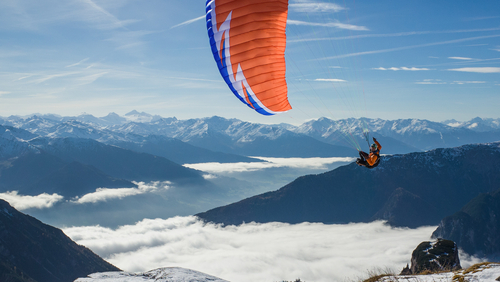
Lightness and durability. Our mission when developing the MENTOR 3 light, was to combine these seemingly contradictory attributes. On the one hand, the wing had to be very light for use in the Red Bull X-Alps, but on the other hand it had to remain suitable for everyday use. As a result of tests in our materials laboratory, we knew that the use of ultra-light 27g sail cloth could lead to warping of the sail and ribs at points of high loading and this means the wing ages more quickly. The answer to the problem was a new 32g light cloth. This combines the attributes of lightness with mechanical strength and durability.
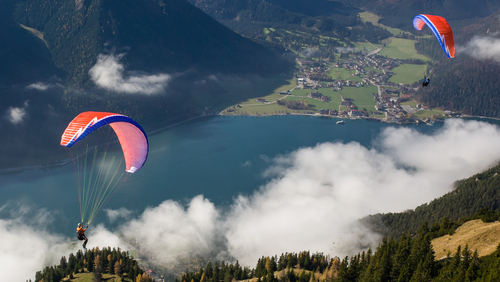
Lightness and flying fun. Thanks to an approximately 1.5kg reduction of canopy weight, the MENTOR 3 light is even easier to launch than the already easy MENTOR 3. The flying characteristics of the MENTOR 3 light are comparable to those of the Mentor 3. The light is easy to turn, pulls into the centre of the thermal and always provides a feeling of safety in the air – even in turbulent conditions. The MENTOR 3 light offers ease and joy in flying.
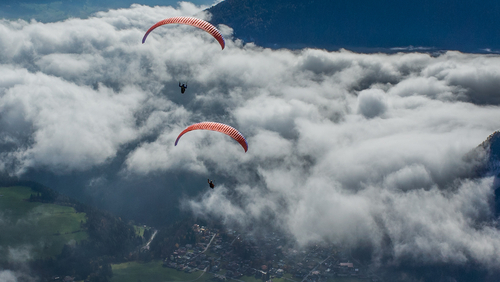
Performance and honesty. The MENTOR 3 light is certified without a folding line, like all NOVA gliders. At NOVA we place great importance on honesty in glider manufacturing – the customer needs to know what they are buying. In this sense, the MENTOR 3 light is a glider which requires a degree of skill, but which is perfectly manageable for a practised pilot. The use of very flexible rods is limited to the leading edge; the A lines have not been set back and the aspect ratio remains very moderate at 5.43 (flat). The MENTOR 3 light is therefore a wing of exceptional performance, which at the same time offers a high degree of passive safety (in regard to its class).
Target group
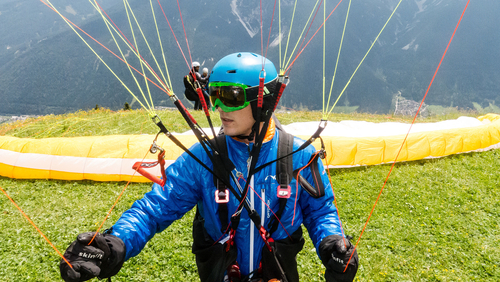
The MENTOR 3 light is a paraglider with impressive performance which has - in the hands of an experienced pilot - a very manageable handling and extreme flight behaviour. Flying the MENTOR 3 light does require a degree of skill. Although certified as EN B, the MENTOR 3 light is not suitable for beginners and occasional pilots.
For queries about the suitability of the wing for you, your NOVA dealer will be happy to assist!
Technologies
Technical data
| XXS | XS | S | M | L | ||
|---|---|---|---|---|---|---|
| Number of cells | - | 51 | 51 | 51 | 51 | 51 |
| Projected span | m | 8,46 | 8,9 | 9,32 | 9,72 | 10,11 |
| Projected area | m² | 18,36 | 20,33 | 22,30 | 24,26 | 26,21 |
| Projected aspect ratio | - | 3,90 | 3,90 | 3,90 | 3,90 | 3,90 |
| Flat span | m | 10,86 | 11,42 | 11,96 | 12,48 | 12,97 |
| Flat area | m² | 21,68 | 24,00 | 26,33 | 28,65 | 30,96 |
| Flat aspect ratio | - | 5,43 | 5,43 | 5,43 | 5,43 | 5,43 |
| Line diameter | mm | 0,6 / 0,7 / 0,8 / 1,3 | ||||
| Line length | m | 6,27 | 6,60 | 6,91 | 7,21 | 7,49 |
| Total line length | m | 216 | 227 | 238 | 249 | 259 |
| Max. chord | m | 2,49 | 2,60 | 2,72 | 2,84 | 2,95 |
| Min. chord | m | 0,62 | 0,65 | 0,68 | 0,71 | 0,74 |
| Weight | kg | 3,4 | 3,7 | 4 | 4,3 | 4,6 |
| Recommended take off weight | kg | 60-80 | 70-90 | 80-100 | 90-110 | 100-130 |
| Certification (EN/LTF) | - | B | B | B | B | B |
Materials
| Leading edge: | DOKDO 20 DMF WR, 35 g/m² |
|---|---|
| Top surface: | Porcher Sport Skytex Universal, 32 g/m² |
| Bottom surface: | Porcher Sport Skytex Universal, 27 g/m² |
| Profile ribs (with line suspension point): | Porcher Sport Skytex Hard, 32 g/m² |
| Profile ribs (without line suspension point): | Porcher Sport Skytex 27 Universal 27 g/m² |
| Main lines: | Liros PPSL 160 Red and Yellow -(Dyneema) |
| Gallery lines: | Edelrid A8000-U70 Red (Aramid), Edelrid A8000-U90 Red (Aramid) |
| Brake lines: | Liros DC 60 Rot (Dyneema), Edelrid 7850-240 Orange (Dyneema) |
| Risers: | Cousin Trestec Webbing PER/Aramid CSAR Black, 12 mm |
Service
Every NOVA paraglider comes with a big package of extra services and guarantees. When you buy the wing you get more than just the product1.
During the initial flights the lines are subjected to real loads for the first time. This leads to stretching and shrinking - regardless of which line material is used. During NOVA Trim Tuning² our software analyses how out of trim the glider has become and then calculates the required correction values. Trim Tuning aids safety and increases your flying fun.
The NOVA Full Service is more than just a check. Just like the Trim Tuning, we analyse the line lengths and ensure that the wing is restored to the optimal profile alignment across the whole of the span. Additionally we give the wing a full health check. Our NOVA Full Service gives you confidence in your wing.
If your wing has undergone NOVA Trim Tuning, the date to the next check is extended from two years to three years. The two-year check becomes a three-year check. This allows you to have an extra year of carefree flying. Please note the maximum permitted flying hours in the manual.
As standard, NOVA provides a three year, rather than a two year, guarantee on its paragliders. If your wing has undergone NOVA Trim Tuning and a NOVA Full Service, then we will extend the guarantee for a further year to four years. You get a good feeling flying a NOVA wing.
If you register your wing at myNOVA, it is added to our Quality Assurance Database. In the database - accessed through myNOVA - you can download all the key data about your wing. The database will also assist the person servicing your glider by getting information about your glider at the click of a button. Your glider will be more comprehensively checked.
1 The guarantee and service provision is limited, subject to conditions and not offered to the same extent in all countries. Detailed information is available in our guarantee conditions.
2 This service is included in the purchase price in selected countries. Please contact your dealer for more information.
FAQ
Where the glider is flown in the weight-range is first and foremost a question of personal preference: anyone seeking a high degree of agility and dynamic flying should fly our wings at the higher end of the weight-range. Pilots who are happier with gentle flights with a high degree of damping will be happier in the middle of the weight-range. Of course, the flying conditions have a big influence - in turbulent, windy conditions greater wing loading will bring greater stability; whereas flying the glider at the lower end of the weight-range makes it unbeatable in weak thermals. Correct wing loading is mainly a question of personal preference and the conditions in which you mainly fly. Your Nova dealer will be happy to advise you!
The brakes are components relevant to certification - modification can affect the flying characteristics and extreme flight behaviour. Because of this, we strongly advise against any modification of the brake system. It is important that the brake has sufficient travel before it engages. This is also important so that the wing does not brake automatically when the speed bar is used. Furthermore a brake that engages too early affects performance and influences the recovery during incidents, for example during a collapse or when the canopy goes parachutal.
Performance data depends heavily on the drag created by the pilot and this is linked to their seating position and harness type. An aerodynamic harness or seating position can make the difference of one glide ratio point. We at NOVA never determine absolute performance data, instead we make comparisons with reference gliders. For this reason we do not publish performance data.
The way a pilot holds the brake handles is a matter of personal preference - but it does have significant influence on the handling and flying characteristics of the wing. We recommend a half-wrap. You hold the brake handle in your palm and twist it half way around your hand so that the brake line lies between your thumb and forefinger. This shortens the brake travel by approximately 20 centimetres and this has a positive effect on feedback - firstly you directly feel the travel of the brake line and secondly, with the arms positioned higher, it is easier to feel the wing. The exception is of course when gliding or during other phases of the flight when steering with the brake is not necessary. Please note: when changing from no-wrap to half-wrap, the shortened brake travel must be taken into consideration.
The ION is less dynamic than the MENTOR. The ION is suitable for pilots desiring more comfort and a more relaxed feel while in the air. In comparison, the MENTOR is sportier.
Simplicity is our motto. Our wings can be packed using a concertina bag, but it is not essential. You can fold this wing using your preferred method and pack it in our stuff sack. Be careful not to bend the leading edge rods unnecessarily. This is particularly true if the wing is to be stored for longer periods or if it is packed tightly.
Sail cloth, lines and all other components are subjected to rigorous testing before they are used in serial production. We not only test the sail cloth for durability (high porosity or reduced tear resistance through UV damage or wear) but also for mechanical robustness, for example stretching. For quality control purposes we regularly take samples during serial production.
During the initial flights the lines are first subjected to load. This load induces a small degree of stretching and shrinking. These are not associated with the line manufacturers or the quality of workmanship - in the factory all NOVA paragliders are trimmed and pre-stretched to within a very low tolerance. To adjust this stretching or shrinking, we recommend that the wing is taken for NTT (NOVA Trim Tuning) after ten to twenty flights - after one year at the very latest. Generally, the line lengths remain constant after the first ten to twenty hours. To make full use of the NTT, NOVA encourages all pilots to have their wing checked after ten to twenty flying hours.
Dry, not packed too tightly and if possible in a space without wide temperature variations - these are the conditions that make our paragliders feel well. You should never store a wing when it is moist. You should also avoid excessive heat, like you would have, for example, in the car. Never remove dirt using chemical detergents and/or brushes.


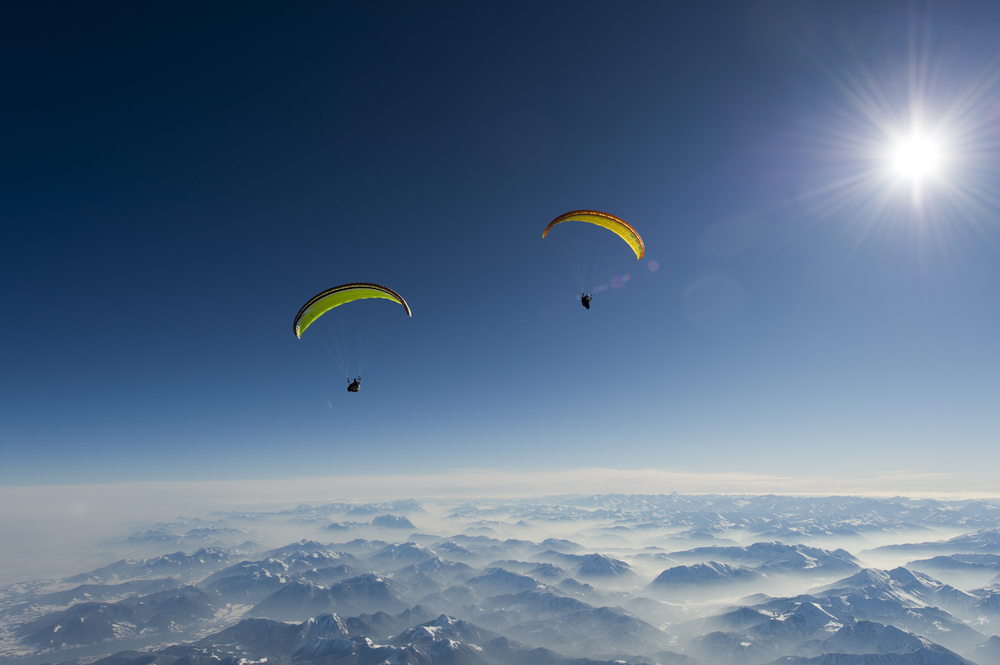
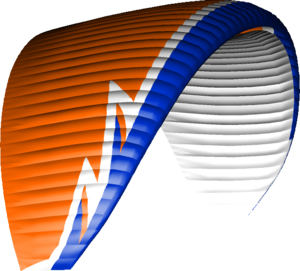 Orange Splash
Orange Splash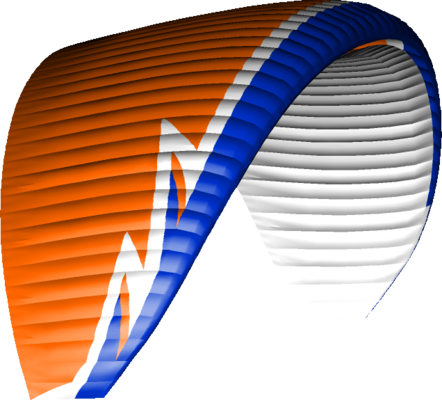







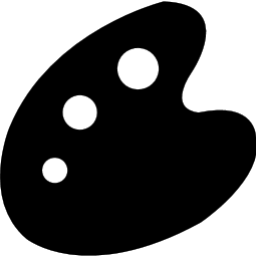

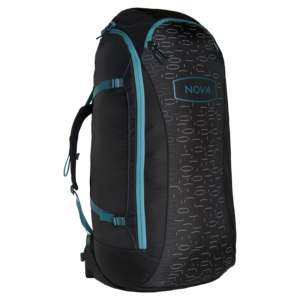 NOVA Rucksack.
NOVA Rucksack.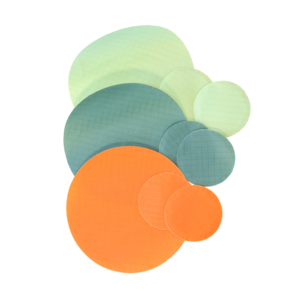 Repair kit.
Repair kit.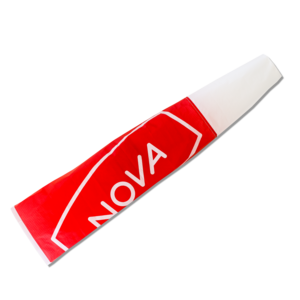 NOVA windsock.
NOVA windsock.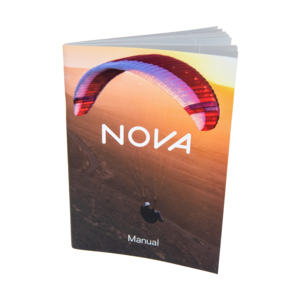 Manual.
Manual.